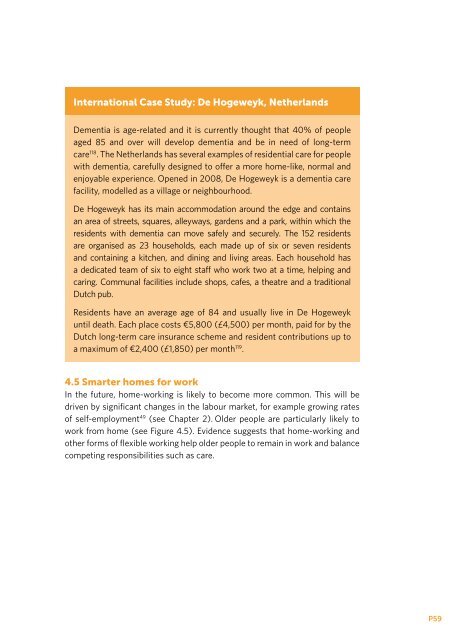Future of an Ageing Population
gs-16-10-future-of-an-ageing-population
gs-16-10-future-of-an-ageing-population
Create successful ePaper yourself
Turn your PDF publications into a flip-book with our unique Google optimized e-Paper software.
International Case Study: De Hogeweyk, Netherl<strong>an</strong>ds<br />
Dementia is age-related <strong>an</strong>d it is currently thought that 40% <strong>of</strong> people<br />
aged 85 <strong>an</strong>d over will develop dementia <strong>an</strong>d be in need <strong>of</strong> long-term<br />
care 118 . The Netherl<strong>an</strong>ds has several examples <strong>of</strong> residential care for people<br />
with dementia, carefully designed to <strong>of</strong>fer a more home-like, normal <strong>an</strong>d<br />
enjoyable experience. Opened in 2008, De Hogeweyk is a dementia care<br />
facility, modelled as a village or neighbourhood.<br />
De Hogeweyk has its main accommodation around the edge <strong>an</strong>d contains<br />
<strong>an</strong> area <strong>of</strong> streets, squares, alleyways, gardens <strong>an</strong>d a park, within which the<br />
residents with dementia c<strong>an</strong> move safely <strong>an</strong>d securely. The 152 residents<br />
are org<strong>an</strong>ised as 23 households, each made up <strong>of</strong> six or seven residents<br />
<strong>an</strong>d containing a kitchen, <strong>an</strong>d dining <strong>an</strong>d living areas. Each household has<br />
a dedicated team <strong>of</strong> six to eight staff who work two at a time, helping <strong>an</strong>d<br />
caring. Communal facilities include shops, cafes, a theatre <strong>an</strong>d a traditional<br />
Dutch pub.<br />
Residents have <strong>an</strong> average age <strong>of</strong> 84 <strong>an</strong>d usually live in De Hogeweyk<br />
until death. Each place costs ¤5,800 (£4,500) per month, paid for by the<br />
Dutch long-term care insur<strong>an</strong>ce scheme <strong>an</strong>d resident contributions up to<br />
a maximum <strong>of</strong> ¤2,400 (£1,850) per month 119 .<br />
4.5 Smarter homes for work<br />
In the future, home-working is likely to become more common. This will be<br />
driven by signific<strong>an</strong>t ch<strong>an</strong>ges in the labour market, for example growing rates<br />
<strong>of</strong> self-employment 49 (see Chapter 2). Older people are particularly likely to<br />
work from home (see Figure 4.5). Evidence suggests that home-working <strong>an</strong>d<br />
other forms <strong>of</strong> flexible working help older people to remain in work <strong>an</strong>d bal<strong>an</strong>ce<br />
competing responsibilities such as care.<br />
P59


